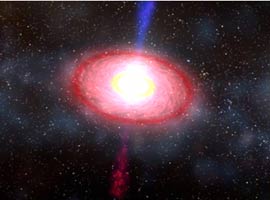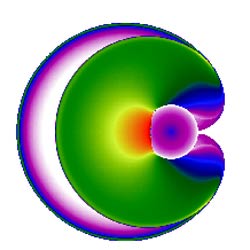
Artist Dana Berry depicts the short gamma-ray burst (GRB) that occurs when a neutron star falls into a black hole. Astronomers are beginning to realize that other violent events can also cause short GRBs.
Courtesy NASA / GSFC / Dana Berry.
Just when astronomers thought they had solved one of astronomy's deepest mysteries — the origin of short gamma-ray bursts (GRBs) — Mother Nature has thrown them for a loop. The so-called "short GRBs" typically release the energy of a billion Suns during an intense pulse of high-energy radiation that lasts at most two seconds. Thanks to NASA's Swift and HETE-2 satellites, astronomers have made great strides in the past year in understanding these enigmatic explosions. But the more data scientists collect, the less they seem to know.
A few months ago, astronomers, press releases, and media outlets (including Sky & Telescope) were proclaiming that short GRBs had been explained. Based on the precise localizations of several short GRBs from Swift and HETE-2, and from follow-up observations by an array of telescopes in space and on the ground, most astronomers were convinced that short GRBs are ignited by the catastrophic merger of two neutron stars, or a neutron star and a black hole. This origin differs from GRBs that last longer than 2 seconds (long GRBs), which are associated with the explosions of massive stars.
Recent observations, however, are showing that short GRBs are much more complicated and diverse than astronomers had imagined, and that a variety of violent processes might be responsible for them. As Joshua Bloom (University of California, Berkeley) explains, "I think the verdict is still very much out. Nature is not letting us off easy."
According to merger models, when two neutron stars spiral into each other, the resulting object usually collapses instantaneously into a black hole. A small amount of remaining gas settles into a small disk around the black hole. As disk material spirals into the black hole, magnetic fields channel some of it into twin jets shooting away in opposite directions at near-light speed. Turbulent shock waves within a jet produce the GRB. This scenario seemed to do a beautiful job of explaining short GRBs, including their brief durations, their energies, and their locations far from star-forming regions.
But short GRBs are not cooperating with theorists' expectations. For example, Swift observed a short GRB on July 9, 2005, and another on July 24th. Each of these bursts was followed by powerful X-ray flares minutes after the main burst. The total energy of these later flares was nearly the same as that contained in the main bursts itself. The merger model failed to anticipate these flares because it predicts that almost all of the leftover gas will fall into the black hole within one or two seconds. The central engine quickly shuts off due to the lack of fuel to power subsequent flares.
Another short GRB, which was observed on December 21, 2005, stunned astronomers because its total energy was about the same as a typical long GRB. This was in stark contrast to previously studied short GRBs, which packed at most 10 percent the energy of long bursts. Radio observations also indicated that the central engine of the December 21st event continued to inject energy into the surrounding gas for several hours after the initial explosion. "That is hard to fit with the merger model, or any model," says Alicia Soderberg (Caltech), who led a team that studied this GRB at radio, optical, and X-ray wavelengths.
These discoveries are challenging the creativity of theorists by forcing them to devise new explanations. Some researchers are abandoning the merger model, whereas others are attempting to tweak the model to account for the X-ray flares. "Theorists have sharpened their pencils and realized that there are other ways you can make a short burst," says Swift lead scientist Neil Gehrels (NASA/Goddard Space Flight Center).

This frame from a computer simulation shows the blast wave from a short GRB slamming into and wrapping around a companion star. The violent interaction can give rise to X-ray flares seconds to minutes after the burst. Amazingly, the star (blue and purple circle on the right) survives this powerful disturbance. Click on the image to view additional frames from the animation.
Courtesy Andrew MacFadyen.
In a paper submitted to the Astrophysical Journal, Andrew MacFadyen (Institute for Advanced Study) and two colleagues propose that some short GRB progenitors could be binary systems consisting of a neutron star and a normal star. Material streaming from the normal star builds up on the neutron star, until the star can no longer support the sheer weight of accumulated mass. It collapses gravitationally into a black hole, triggering a short GRB. The violent explosion hurls ejecta outward at nearly the speed of light. Some of this material slams into the companion star, generating an X-ray flare.
In the February 24th Science, Zigao Dai (Nanjing University, China) and three colleagues report a model that can salvage the merger scenario while also explaining the X-ray flares. In this picture, two relatively lightweight neutron stars merge and produce a short GRB. But the combined mass of the two objects can still remain below the maximum mass of a neutron star, so the merger produces a heavy neutron star of nearly 3 solar masses. The newly formed neutron star rotates hundreds of times per second. Just as the Sun rotates faster at its equator than at its poles, "differential rotation" winds up magnetic field lines inside the neutron star. Magnetic stress builds up for dozens of seconds until this pent-up energy is released in a powerful explosion. This explosion hurls off chunks of ejecta in a blazing fireball. As fast-moving chunks slam into slower-moving chunks, they produce X-ray flares with properties similar to those observed by Swift. This process can repeat itself several times, so Dai's model can explain why the July 24th GRB produced five X-ray flares.
Both Bloom and MacFadyen are quick to draw analogies to supernovae, some of which are exploding massive stars, and others are exploding white dwarfs. It's a fluke of nature that even though the two major supernova mechanisms are quite different, they produce explosions with similar levels of energy. "I think there could be a multiplicity of sources for short GRBs, as is the case for supernovae," says MacFadyen.
Astronomers already know that perhaps 10 percent of short GRBs have nothing to do with mergers. These events originate in nearby galaxies when highly magnetized neutron stars, known as magnetars, unleash powerful flares that produce a torrent of gamma rays for just one or two seconds. Such a flare was observed from a Milky Way magnetar on December 27, 2004. Six spacecraft probably observed an extragalactic magnetar flare last November 3rd coming from the M81 Group of galaxies. From an observational perspective, this event looked very much like a standard short GRB. But its origin might be entirely different than most short GRBs.
Theorists have imagined other rare but violent processes that could unleash fleeting bursts of gamma rays with staggering levels of energy. One possibility is an event called a supranova. In this case, the collapsing core of a massive star produces an extremely heavy neutron star that actually exceeds the maximum mass of a neutron star (which falls somewhere between 2 and 3 solar masses). If the neutron star spins extremely fast, centrifugal forces can temporarily prevent it from collapsing into a black hole. But eventually the spin slows down, sealing the neutron star's fate and triggering a delayed short GRB in the process.
Further observations by Swift, HETE-2, and other observatories may reveal new types of short GRBs, or help astronomers unravel the mystery. If a short GRB were to happen in a nearby galaxy, gravitational-wave observatories such as LIGO might pick up ripples in the fabric of space-time generated by the violent event. This simultaneous observation might provide the key that unlocks the mystery.
In the meantime, astronomers are struggling to decipher the details of long GRBs. There is overwhelming evidence that these explosions represent the gravitational collapse of a massive star that rotates fast and has a low concentration of heavy elements. This collapse produces a supernova as well. Astronomers are hoping that a relatively nearby long GRB observed on February 18th will provide new details about the link between GRBs and supernovae.
As for the short bursts, MacFadyen says, "The most important thing is to keep an open mind. It's not a slam-dunk that it's neutron-star mergers."
 0
0
Comments
You must be logged in to post a comment.